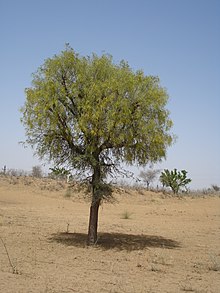| Prosopis cineraria | |
|---|---|

| |
| Scientific classification | |
| Kingdom: | Plantae |
| Clade: | Tracheophytes |
| Clade: | Angiosperms |
| Clade: | Eudicots |
| Clade: | Rosids |
| Order: | Fabales |
| Family: | Fabaceae |
| Subfamily: | Caesalpinioideae |
| Clade: | Mimosoid clade |
| Genus: | Prosopis |
| Species: | P. cineraria
|
| Binomial name | |
| Prosopis cineraria | |
| Synonyms | |
|
Adenanthera aculeata Roxb.[1] | |
Prosopis cineraria, also known as Persian mesquite or ghaf, is a species of flowering tree in the pea family, Fabaceae. It is native to arid portions of Western Asia and the Indian Subcontinent, including Afghanistan, Bahrain, Iran, India, Oman, Pakistan, Saudi Arabia, the United Arab Emirates, and Yemen. Its leaves are bipinnate. It can survive extreme drought. It is an established introduced species in parts of Southeast Asia, including Indonesia.[dead link][1]
The ghaf is the national tree of the United Arab Emirates. Through the Give a Ghaf campaign its citizens are urged to plant it in their gardens to combat desertification and preserve their country's heritage.[3] The desert village of Nazwa in the UAE is home to the Al Ghaf Conservation Reserve.[4]
Prosopis cineraria is also the state tree of Rajasthan (where it is known as khejri), Western Uttar Pradesh (where it is known as chhonkara) and Telangana (where it is known as jammi[5]) in India. A large and well-known example of the species is the Tree of Life in Bahrain; it is approximately 400 years old and growing in a desert devoid of any obvious sources of water.
In 1730 AD, the village of Khejarli near Jodhpur in Rajasthan was the scene of a violent environmental confrontation. Amrita Devi and her three young daughters gave their lives in an attempt to protect some khejri trees which Maharaja Abhay Singh had ordered cut to make way for his new palace. This led to widespread defiance in which 363 people were killed trying to save the trees. In the 1970s, the memory of this sacrifice led to the start of the Chipko movement.[6]
- ^ a b c "Prosopis cineraria (L.) Druce". Catalogue of Life. Integrated Taxonomic Information System and Species2000. 15 March 2012. Retrieved 21 March 2012.
- ^ "Prosopis cineraria". Germplasm Resources Information Network. Agricultural Research Service, United States Department of Agriculture. Retrieved 31 December 2009.
- ^ Philp, Myra (17 June 2013). "UAE groups help to save ghaf trees on UN 'Combat Desertification Day'". 7DAYS in Dubai. Al Sidra Media. Archived from the original on 12 October 2013. Retrieved 21 March 2018.
- ^ "Six natural reserves declared in Dubai". The National. Retrieved 9 September 2018.
- ^ "What's common to jinka, paalapitta, jammi chettu and thangedu puvvu?". The Hindu. Retrieved 20 October 2018.
- ^ "Khejri, the tree that inspired Chipko movement, is dying a slow death". 4 December 2016.